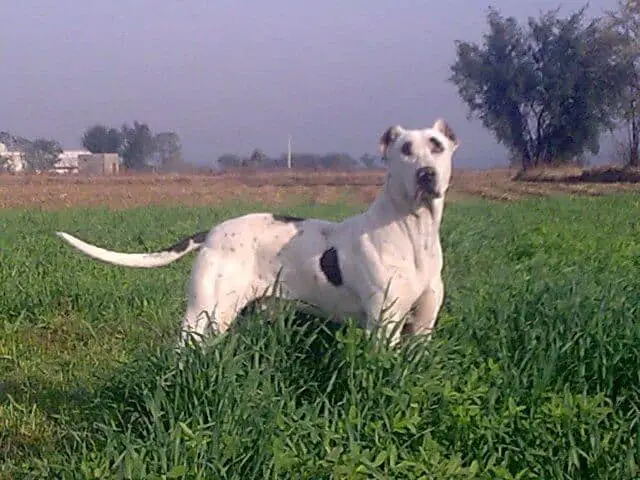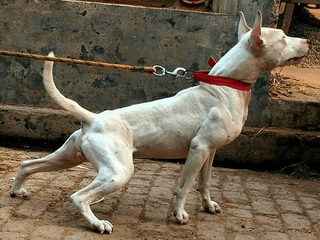Pakistan Dog Breeds aren’t that common elsewhere in the world, but they are some of the most amazing dogs on the planet.
Some of the breeds have Western equivalents, but obviously there are subtle differences between the breeds.
Many of them have their roots in ancient culture, often dating back thousands of years.
You will probably find it difficult to track down a breeder of Pakistan dog breeds in the west, but this doesn’t mean they’re impossible to find.
However, due to the rarity of the breeds, you will expect to pay much more for them than common breeds.
That said, if a breed takes your fancy, you should be able to find a respectable breeder if you’re committed.
Here is more information about the top 3 Pakistan dog breeds.
Pakistani Mastiff (Bully Kutta)

It can trace its origins back to the 16th century, although the breed may be much older.
This dog originated in India but became widespread across India and Pakistan over the next centuries.
It’s now commonly kept as a pet but is still used as a working dog in more rural parts of the country.
The breed’s original name is “Bully Kutta”, meaning heavily wrinkled dog.
Its original name is in Punjabi, so shouldn’t be confused with the slang word “bully” that’s often used to describe bulldogs or Pitbulls.
The breed is unrelated to either of these and shares more similarities with mastiffs, although it’s not related to them either.
The Bully Dog was first shown in the UK in 1864 and was kept by various members of the royal family as a hunting dog.
The breed was originally used as a working dog and was traditionally used for hunting and guarding.
However, in recent years, the breed has been used in illegal dog fighting rings across India, which has been recognized as a big problem that the government is now trying to deal with.
Although they’re used as fighting dogs, they’re not a particularly aggressive breed, and it requires a lot of cruel training to instill blood lust in them.
Check Out Korean Mastiff’s similarities with this breed.
Pakistani Mastiff Appearance
The Pakistani Mastiff is a very large dog, standing around 2.7ft tall.
On average, they can weigh up to 12th 5lbs, although there is quite a bit of variation in this depending on the genetic history of the dog, and the purpose it was bred for.
Unlike more purebred breeds, which are strictly regulated by kennel clubs, the Pakistani Mastiff doesn’t have to conform to regulations because it’s still regularly used as a working dog.
The breed has a long muzzle with jowls that hang down the side of its mouth.
They have large ears that fold over and a very muscular body. As a breed, they’re incredibly strong, something potential owners should bear in mind.
If the dog wants to go its way, it definitely will.
However, they’re usually very well-behaved, provided they’ve been properly trained.
Pakistani Mastiffs have short coat because they were bred to live in hot climates.
They do shed, but no more than any other shorthaired breed.
Unlike longhaired breeds, they don’t require regular grooming, although the occasional brush is always appreciated.
This means that they’re quite easy to care for, and don’t require anywhere near as much attention as a longhaired dog.
The coat is traditionally brindle, brown, white, black, or a combination of these colors.
Again, because they’re not recognized in the same way by kennel clubs, there are fewer rules for breeders to stick to.
[ Check Out: Iranian Mastiff Here ]
Pakistani Mastiff Temperament
Bully Dogs are known to be very clever and alert and can be very independent.
The breed has plenty of energy and needs lots of exercises.
This is due to them being used as working dogs, so if you plan on keeping one as a pet, you have to be prepared to take it on several long walks a day or make sure you have plenty of lands for it to run around.
The breed is also known to be aggressive, although this isn’t true of every dog.
This is again a result of the purpose they were bred for, and so realistically is something you’d struggle to train out of them.
Vets that have worked with the breed extensively recommend that very experienced owners only keep them for this reason.
That said, the idea of aggression in the breed is a hotly debated topic.
Like other better-known breeds, such as Pitbulls, Pakistani Mastiffs received bad press after several unrelated incidents involving them mauling smaller dogs.
This has given them a bad reputation, but some owners and kennel clubs believe them to be less aggressive than some of the most relaxed breeds, including beagles.
Much like with any other large dog, the idea of aggression should be taken with a pinch of salt.
While the breed did serve as guard dogs, and they definitely have the size to put behind their aggression, this won’t be true of every Pakistani Mastiff.
Much of it comes down to the way they’re raised, and provided the dog is socialized and trained from an early age, there should be little risk of aggression.
Related questions
Are Pakistani Bullies dangerous?
As mentioned, by their nature, Pakistani Mastiffs are very intelligent and strong-minded but can also be very protective.
You should only consider them if you’re experienced raising dogs, particularly large ones.
You should be able to assert your dominance over the dog, not in a physical way, but by showing confidence in your actions.
This isn’t something new dog owners are often capable of, so be wary if you don’t have much experience owning dogs.
Is Bully Kutta a good family dog?
The answer to this question greatly depends on how the dog is raised.
Providing they’re introduced to children from a young age, they can be very good with them and are much more resilient than smaller dogs.
However, be wary of having a rescue dog around children simply because you don’t know the dog’s history, and due to their size, they will be very difficult to control if they become aggressive.
Gull Terrier

They were first bred during the British Raj in India and were developed by breeding Bull Terriers and Bully Kuttas, along with other breeds.
The breed is now several hundred years old but isn’t particularly popular outside Pakistan and India, mainly because other more common breeds are more readily available.
The Gull Terrier was first bred for several different roles, including being a guard dog, hunting, and dogfighting.
Nowadays, they’re still used as guard dogs by families and are unfortunately used in illegal dog fights, but this is being worked on by the local governments.
Gull Terriers are a medium-sized breed that closely resembles Staffordshire Bull Terriers but has slightly longer faces.
They can weigh between 45 and 65 lbs depending on sex and typically stand between 18 and 22 inches high.
They’re very muscular dogs with stocky physiques, which makes them incredibly strong.
For this reason, owners must be assertive when walking them because they could easily pull away if the walker isn’t paying enough attention.
They have short, dense fur and are typically only white.
This is because they were bred for use in hot climates, and so white fur makes it less likely that they’ll overheat.
This also means they don’t shed as much and require significantly less grooming than a longhaired breed.
Some owners may trim their fur even shorter, but this is only necessary for hot climates.
Gull Terrier Temperament
Gull Terriers were bred as guard dogs and so are very wary around strangers.
They’re also very protective dogs and can become aggressive if they believe their owners are under threat.
Realistically, these are also traits associated with most Terrier breeds, so the information must always be taken with a pinch of salt.
Much of it will come down to how the dog is raised and how well their owners train them.
Even though they’re often labeled as aggressive dogs, they’re known to be very good around children; however, this is only really recognized within their immediate family.
Much like with any other dog, it’s best to introduce them to children from a young age; otherwise, there’s less guarantee of the dog’s behavior.
That said, be mindful if you plan on getting one if you have children because there’s never a complete guarantee the dog will be fine, so it’s always best to consider a breed that’s recognized as being good with children rather than taking a chance.
Gull Terriers are very clever dogs and are known to be very alert.
They’re also known as barkers because they were bred as guard dogs, which often puts off potential owners.
They’re very fast and agile because they’re so muscly and require plenty of daily exercise.
You should expect to take them on several long walks every day or ensure they have plenty of land to run around on.
They can be kept in an apartment because they’re easy to house train, but you must be committed to walking their lots daily.
Also, they’re very easy to train when it comes to obedience and quickly pick up commands.
They can be taught more complex commands than many other breeds, which can be very useful for ensuring their behavior.
Much like with other Terrier breeds, there are some bans on the Gull Terrier.
The New York City Housing Authority bans Gull Terriers from being kept in homes and is also completely banned from the Cayman Islands.
These bans often occur after a breed receives bad press, often regardless of how accurate it is.
Gull Terrier Health
For the most part, Gull Terriers are quite a healthy breed.
Many genetic conditions found in dogs result from them being massively overbred (and interbred), which isn’t such a big problem with Gull Terriers because kennel clubs do not recognize them.
This usually gives rise to genetic conditions because breeders have strict requirements to adhere to, which often results in interbreeding.
The only real conditions found in the breed are blindness and deafness, although these aren’t particularly common and only really set in when the dog gets older.
Overall, they’re a healthy breed, which is a big plus for many owners because you don’t have to spend ridiculous amounts on vet bills.
Vikhan Sheepdog
The Vikhan Sheepdog is one of the better-known Pakistan dog breeds and originates from northwestern Pakistan.
It isn’t recognized by any major kennel club anywhere in the world, but this works better for the breed because it means breeders aren’t kept to the same high standards as purebred dogs.
This results in the breed having a more traditional appearance and more variation in size and weight.
The Vikhan Sheepdog has been used for several hundred years as a livestock dog but was also used for hunting leopards.
Much like other Asian dog breeds, it isn’t related to what we think of as sheepdogs, although this is a standard name given to any dog that guards livestock.
The breed isn’t used for hunting purposes anymore, but is still commonly used as a livestock dog and is becoming more popular in India and Pakistan simply as a pet.
Vikhan Sheepdog Appearance

Vikhan Sheepdogs are large and muscular but also very lean.
They stand around 25 inches tall, but as mentioned, there is some variation in this because there isn’t a breed standard.
This also means there’s a great deal of variation in weight, and the breed is considerably lighter than other dogs of comparable size, mainly because they were bred for speed.
Their coat is long and shaggy and usually comes in black, fawn, or brown.
However, it’s also common to find dogs with a combination of these colors.
Their long coat does shed somewhat, and it requires regular grooming to remove knots and debris, and to keep it in good condition.
In some parts of Pakistan its coat is used as a substitute for wool and can be woven into carpets and other textiles. For this reason, the coat is also very soft and can be spun easily.
Vikhan Sheepdog Temperament
Much of a Vikhan Sheepdog’s temperament is based on its use as a livestock herding animal, which means it’s incredibly intelligent and very fearless.
This also means they pick up commands very easily and can be taught very complex things.
If you were to enter one into an agility competition, it’s almost guaranteed that the dog would do very well.
While they’re a very clever breed, their working purpose also means they’re quite protective and are known to be aggressive in some situations.
To combat this, Vikhan Sheepdogs should be socialized early and should not be around children.
They can be fine with other dogs, but you must be intelligent about where and when you introduce them.
For example, bringing a strange dog into their home would be very bad, but introducing them in a neutral environment would have a much greater chance of success.
Vikhan Sheepdogs also need a great deal of exercise; otherwise, they can become bored and possibly destructive.
As a breed, they’re used to working all day, much of which is spent herding animals so will need several long walks every day.
This is often enough to put potential owners off a breed and also means it wouldn’t be a good idea to get one if you live in an apartment.
However, they can make you an excellent pet if you’re committed to long walks.
Due to the breed not being very common outside of Pakistan and India, you would probably struggle to find a breeder.
Also, there is little information available about the lifespan and health of the breed, which is always useful information to know before committing to getting a dog.
If you truly are interested in getting one, breeders of similar dogs would likely be a good place to start because there are often networks of breeders who can provide more information about specialist or rare breeds.
Conclusion:
Pakistan dog breeds aren’t well known outside of Asia and are typically used for their original working purposes.
They’re not even commonly kept as pets within their home countries, as they still serve useful roles in the lives of their owners.
However, they will likely become more popular in the coming years as Western breeders look for the “next big thing.”
If you’re interested in any breeds on this list, start with some online research.
As mentioned, specialist breeders would be a good place to start because they can point you in the right direction.
However, it would help if you always were wary of breeders in this situation and should always visit the dogs before you commit to buying.
Wherever possible, get health checks done on a dog before you commit to buying, and discuss everything in detail with the breeder.
Here are the rest of Asian Dog Breeds:


